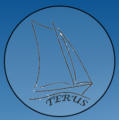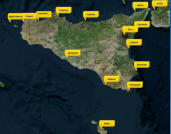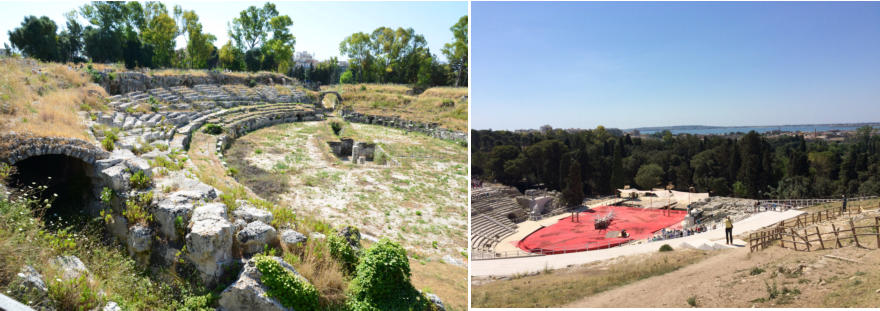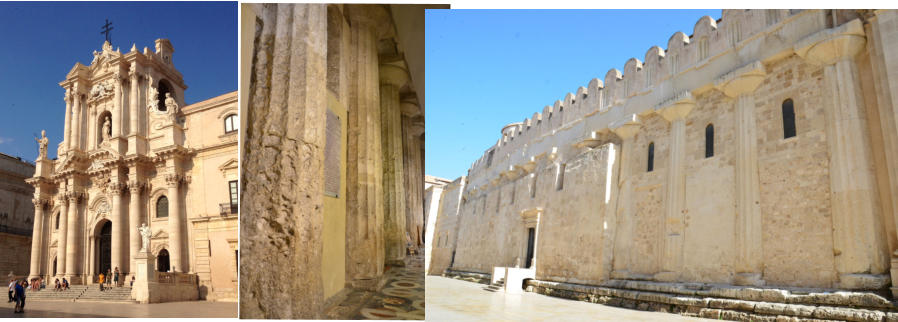











Our Journey: 2017
Syracuse: (June 2017 and May 2018)

The most important city to visit on the East coast of Sicily is Syracuse, founded in 742 BC. The city became more and more important and in around the 5th century BC was competing with
city became more and more important and in around the 5th century BC was competing with Carthage and Athens. Athens even sent an army to fight Syracuse, but unfortunately, they lost
Carthage and Athens. Athens even sent an army to fight Syracuse, but unfortunately, they lost and 7,000 of their soldiers were captured and died in the quarries of Syracuse. The historical
and 7,000 of their soldiers were captured and died in the quarries of Syracuse. The historical park of Syracuse is interesting to visit as there is a Greek theatre that could accommodate
park of Syracuse is interesting to visit as there is a Greek theatre that could accommodate 15,000 people. Today it is still used for Greek plays. Once the Romans took control of Syracuse
15,000 people. Today it is still used for Greek plays. Once the Romans took control of Syracuse in the year 214BC , they started building an amphitheatre next to it so that the gladiators could
in the year 214BC , they started building an amphitheatre next to it so that the gladiators could entertain the public. To build the amphitheatre some stones from the Greek theatre were used.
entertain the public. To build the amphitheatre some stones from the Greek theatre were used. Today there are no more performances in the amphitheatre as gladiators are nowhere to be
Today there are no more performances in the amphitheatre as gladiators are nowhere to be found.
found.
 South of Syracuse is the island of Ortiglia. This is really the original part of Syracuse and
South of Syracuse is the island of Ortiglia. This is really the original part of Syracuse and several ruins of Greek temples are still visible on the island. The most important one is the
several ruins of Greek temples are still visible on the island. The most important one is the Cathedral also called the Duomo. Today it is a catholic cathedral, but in the past it was a Greek
Cathedral also called the Duomo. Today it is a catholic cathedral, but in the past it was a Greek temple devoted to the god Athena. The original columns of the temple are still visible and are
temple devoted to the god Athena. The original columns of the temple are still visible and are part of the wall of the basilica. Inside the basilica you can only be impressed by those columns
part of the wall of the basilica. Inside the basilica you can only be impressed by those columns that once were part of a Greek temple. Outside, you can also detect some byzantine
that once were part of a Greek temple. Outside, you can also detect some byzantine architectural elements on the Duomo.
architectural elements on the Duomo.
 Another cathedral, this time on the mainland, is the cathedral of the weeping Madonna. In
Another cathedral, this time on the mainland, is the cathedral of the weeping Madonna. In August 1953, in a house of simple people they noticed that the statue of the virgin above their
August 1953, in a house of simple people they noticed that the statue of the virgin above their bed was weeping, shedding tears. This lasted for only three days but it immediately created a
bed was weeping, shedding tears. This lasted for only three days but it immediately created a buzz in Syracuse. After careful analysis, the conclusion was that a miracle had occurred and
buzz in Syracuse. After careful analysis, the conclusion was that a miracle had occurred and since then a lot of people pray to the weeping Madonna. Today a Basilica has been built to
since then a lot of people pray to the weeping Madonna. Today a Basilica has been built to preserve the statue as well as the cloth that caught her tears. The basilica is now visited by a
preserve the statue as well as the cloth that caught her tears. The basilica is now visited by a lot of people who pray in front of the items on display.
lot of people who pray in front of the items on display.
 We visited several museums in Syracuse, but were disappointed by the Archimedes and
We visited several museums in Syracuse, but were disappointed by the Archimedes and Leonardo da Vinci one. Not much is on show and the entry fee is rather on the high side for
Leonardo da Vinci one. Not much is on show and the entry fee is rather on the high side for what is on display. Nevertheless, it is a nice way to remember the great scientist that lived in
what is on display. Nevertheless, it is a nice way to remember the great scientist that lived in Syracuse, Archimedes. He understood the rules of buoyancy and is credited with the invention
Syracuse, Archimedes. He understood the rules of buoyancy and is credited with the invention of parabolic mirrors which enabled them to set approaching vessels on fire. Today many people
of parabolic mirrors which enabled them to set approaching vessels on fire. Today many people believe that it did not work, but the principle was absolutely scientifically possible. On the
believe that it did not work, but the principle was absolutely scientifically possible. On the southern tip of Ortiglia is the Manace castle. Unfortunately, the interesting part was closed for
southern tip of Ortiglia is the Manace castle. Unfortunately, the interesting part was closed for restoration so we could only see the big walls that protect the castle. There is also a little
restoration so we could only see the big walls that protect the castle. There is also a little museum on papyrus. In 230 BC, some papyrus plants were brought and planted along the Ciane
museum on papyrus. In 230 BC, some papyrus plants were brought and planted along the Ciane River north of Syracuse. The plants were used to make papyrus for important documents. Later,
River north of Syracuse. The plants were used to make papyrus for important documents. Later, the know-how was lost and it was only in the 19 century that some people revived, not without
the know-how was lost and it was only in the 19 century that some people revived, not without some difficulty, the manufacturing of papyrus. The little museum is worth a visit as everything
some difficulty, the manufacturing of papyrus. The little museum is worth a visit as everything in it is explained. You can also find things made of this plant such as sandals, baskets and rafts.
in it is explained. You can also find things made of this plant such as sandals, baskets and rafts. In Syracuse, we had an interesting neighbour dock next to us. The vessel, Brigitte Bardot, of
In Syracuse, we had an interesting neighbour dock next to us. The vessel, Brigitte Bardot, of Sea Shepherd was on standby for future missions, but in the meantime with the cooperation of
Sea Shepherd was on standby for future missions, but in the meantime with the cooperation of some local authorities, they were trying to enforce the nature reserves with a particular
some local authorities, they were trying to enforce the nature reserves with a particular interest in the protection of sea urchins. From May to July it is strictly prohibited in Italy to
interest in the protection of sea urchins. From May to July it is strictly prohibited in Italy to catch sea urchins as their reproductive season. Regularly, they caught people who were
catch sea urchins as their reproductive season. Regularly, they caught people who were deliberately ignoring the rules. In the market in Syracuse, we could still see people selling sea
deliberately ignoring the rules. In the market in Syracuse, we could still see people selling sea urchins. (“Ricci” are too popular)
urchins. (“Ricci” are too popular)
 city became more and more important and in around the 5th century BC was competing with
city became more and more important and in around the 5th century BC was competing with Carthage and Athens. Athens even sent an army to fight Syracuse, but unfortunately, they lost
Carthage and Athens. Athens even sent an army to fight Syracuse, but unfortunately, they lost and 7,000 of their soldiers were captured and died in the quarries of Syracuse. The historical
and 7,000 of their soldiers were captured and died in the quarries of Syracuse. The historical park of Syracuse is interesting to visit as there is a Greek theatre that could accommodate
park of Syracuse is interesting to visit as there is a Greek theatre that could accommodate 15,000 people. Today it is still used for Greek plays. Once the Romans took control of Syracuse
15,000 people. Today it is still used for Greek plays. Once the Romans took control of Syracuse in the year 214BC , they started building an amphitheatre next to it so that the gladiators could
in the year 214BC , they started building an amphitheatre next to it so that the gladiators could entertain the public. To build the amphitheatre some stones from the Greek theatre were used.
entertain the public. To build the amphitheatre some stones from the Greek theatre were used. Today there are no more performances in the amphitheatre as gladiators are nowhere to be
Today there are no more performances in the amphitheatre as gladiators are nowhere to be found.
found.
 South of Syracuse is the island of Ortiglia. This is really the original part of Syracuse and
South of Syracuse is the island of Ortiglia. This is really the original part of Syracuse and several ruins of Greek temples are still visible on the island. The most important one is the
several ruins of Greek temples are still visible on the island. The most important one is the Cathedral also called the Duomo. Today it is a catholic cathedral, but in the past it was a Greek
Cathedral also called the Duomo. Today it is a catholic cathedral, but in the past it was a Greek temple devoted to the god Athena. The original columns of the temple are still visible and are
temple devoted to the god Athena. The original columns of the temple are still visible and are part of the wall of the basilica. Inside the basilica you can only be impressed by those columns
part of the wall of the basilica. Inside the basilica you can only be impressed by those columns that once were part of a Greek temple. Outside, you can also detect some byzantine
that once were part of a Greek temple. Outside, you can also detect some byzantine architectural elements on the Duomo.
architectural elements on the Duomo.
 Another cathedral, this time on the mainland, is the cathedral of the weeping Madonna. In
Another cathedral, this time on the mainland, is the cathedral of the weeping Madonna. In August 1953, in a house of simple people they noticed that the statue of the virgin above their
August 1953, in a house of simple people they noticed that the statue of the virgin above their bed was weeping, shedding tears. This lasted for only three days but it immediately created a
bed was weeping, shedding tears. This lasted for only three days but it immediately created a buzz in Syracuse. After careful analysis, the conclusion was that a miracle had occurred and
buzz in Syracuse. After careful analysis, the conclusion was that a miracle had occurred and since then a lot of people pray to the weeping Madonna. Today a Basilica has been built to
since then a lot of people pray to the weeping Madonna. Today a Basilica has been built to preserve the statue as well as the cloth that caught her tears. The basilica is now visited by a
preserve the statue as well as the cloth that caught her tears. The basilica is now visited by a lot of people who pray in front of the items on display.
lot of people who pray in front of the items on display.
 We visited several museums in Syracuse, but were disappointed by the Archimedes and
We visited several museums in Syracuse, but were disappointed by the Archimedes and Leonardo da Vinci one. Not much is on show and the entry fee is rather on the high side for
Leonardo da Vinci one. Not much is on show and the entry fee is rather on the high side for what is on display. Nevertheless, it is a nice way to remember the great scientist that lived in
what is on display. Nevertheless, it is a nice way to remember the great scientist that lived in Syracuse, Archimedes. He understood the rules of buoyancy and is credited with the invention
Syracuse, Archimedes. He understood the rules of buoyancy and is credited with the invention of parabolic mirrors which enabled them to set approaching vessels on fire. Today many people
of parabolic mirrors which enabled them to set approaching vessels on fire. Today many people believe that it did not work, but the principle was absolutely scientifically possible. On the
believe that it did not work, but the principle was absolutely scientifically possible. On the southern tip of Ortiglia is the Manace castle. Unfortunately, the interesting part was closed for
southern tip of Ortiglia is the Manace castle. Unfortunately, the interesting part was closed for restoration so we could only see the big walls that protect the castle. There is also a little
restoration so we could only see the big walls that protect the castle. There is also a little museum on papyrus. In 230 BC, some papyrus plants were brought and planted along the Ciane
museum on papyrus. In 230 BC, some papyrus plants were brought and planted along the Ciane River north of Syracuse. The plants were used to make papyrus for important documents. Later,
River north of Syracuse. The plants were used to make papyrus for important documents. Later, the know-how was lost and it was only in the 19 century that some people revived, not without
the know-how was lost and it was only in the 19 century that some people revived, not without some difficulty, the manufacturing of papyrus. The little museum is worth a visit as everything
some difficulty, the manufacturing of papyrus. The little museum is worth a visit as everything in it is explained. You can also find things made of this plant such as sandals, baskets and rafts.
in it is explained. You can also find things made of this plant such as sandals, baskets and rafts. In Syracuse, we had an interesting neighbour dock next to us. The vessel, Brigitte Bardot, of
In Syracuse, we had an interesting neighbour dock next to us. The vessel, Brigitte Bardot, of Sea Shepherd was on standby for future missions, but in the meantime with the cooperation of
Sea Shepherd was on standby for future missions, but in the meantime with the cooperation of some local authorities, they were trying to enforce the nature reserves with a particular
some local authorities, they were trying to enforce the nature reserves with a particular interest in the protection of sea urchins. From May to July it is strictly prohibited in Italy to
interest in the protection of sea urchins. From May to July it is strictly prohibited in Italy to catch sea urchins as their reproductive season. Regularly, they caught people who were
catch sea urchins as their reproductive season. Regularly, they caught people who were deliberately ignoring the rules. In the market in Syracuse, we could still see people selling sea
deliberately ignoring the rules. In the market in Syracuse, we could still see people selling sea urchins. (“Ricci” are too popular)
urchins. (“Ricci” are too popular)



























